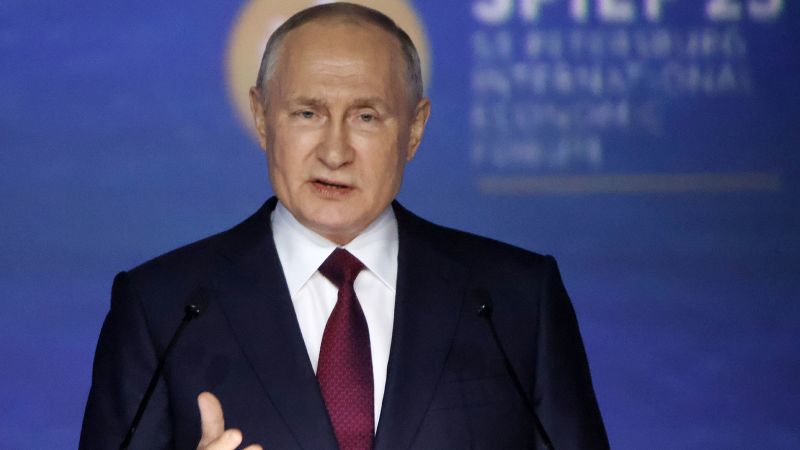DIA Officials Confirm Putin’s Claim of Nuclear Weapons in Belarus
The Defense Intelligence Agency (DIA) has confirmed that Russian President Vladimir Putin’s claim of moving tactical nuclear weapons to Belarus is credible. Despite the lack of public confirmation from US and Western officials, senior DIA officials have stated that they have “no reason to doubt” Putin’s claims. This revelation raises concerns about the global nuclear landscape and the potential risks associated with the presence of these weapons.
No Reason to Doubt Putin’s Claims
According to the Federation of American Scientists, Russia currently possesses around 4,477 deployed and reserve nuclear warheads, including approximately 1,900 tactical nuclear weapons. While it remains unclear how many of these weapons will be transferred to Belarus, the DIA officials have expressed confidence in the success of the operation. However, they have not disclosed the specific reasons behind their belief.
Challenges in Tracking the Weapons
Tracking the movement of these weapons poses a significant challenge for the US intelligence community. Even satellite imagery has proven insufficient in providing accurate information about their location. This difficulty in monitoring the weapons further adds to the concerns surrounding their presence in Belarus.
Mixed Signals and Uncertainty
Earlier reports suggested that Belarus had not completed the necessary upgrades to accommodate tactical nuclear weapons. However, sources have indicated that there are existing facilities in Belarus that could potentially house these weapons. British Defense Secretary Ben Wallace acknowledged signs of progress in the weapons’ movement but declined to provide further details. Similarly, the US State Department expects Russia to uphold its nonproliferation obligations but has not disclosed the actual location of the weapons.
Control and Potential Risks
Belarusian President Aleksander Lukashenko has stated that he would not hesitate to use the Russian tactical nuclear weapons in the face of aggression. However, the DIA officials believe that Russia would maintain full control over the arsenal, diminishing Lukashenko’s influence. They also reassured that the storage of these weapons in Belarus, rather than their deployment, would not significantly alter the global nuclear landscape or increase the risk of a nuclear incident.
No Immediate Threat, but Vigilance Required
While the presence of these weapons raises concerns, US officials have stated that there is currently no indication of Russia preparing to use a nuclear weapon. The US has not adjusted its own nuclear posture in response to this development. However, the DIA officials have emphasized the need for continued monitoring and attention to any deviations by Russia.
Future Transfers and Implications
Putin has announced plans to transfer the remaining tactical nuclear weapons to Belarus by the end of the summer or the end of the year. The successful completion of this operation could have significant implications for regional and global security.
Conclusion
The confirmation of Putin’s claim regarding the movement of nuclear weapons to Belarus by senior DIA officials highlights the potential risks and challenges associated with this development. While the exact location and extent of the weapons’ presence remain uncertain, it is crucial to remain vigilant and closely monitor any further actions by Russia.
Title: US Intelligence Officials Confirm Russia’s Nuclear Weapons Secretly Deployed in Belarus
Introduction
In a recent development that has raised concerns among global security experts, US intelligence officials have confirmed the secret deployment of Russia’s nuclear weapons in Belarus. This revelation has significant implications for regional stability, arms control agreements, and the delicate balance of power in Eastern Europe. The clandestine nature of this deployment underscores the need for increased transparency and cooperation among nations to ensure the preservation of global peace and security.
Background
Belarus, a landlocked country situated between Russia and the European Union, has long been a strategic ally of Moscow. Historically, Belarus has maintained close political, economic, and military ties with Russia, making it an ideal location for the deployment of Russian nuclear weapons. While Belarus is not a nuclear power itself, it has been a party to the Treaty on the Non-Proliferation of Nuclear Weapons (NPT) since 1993, committing to the peaceful use of nuclear energy.
Confirmation of Secret Deployment
US intelligence officials, through extensive surveillance and analysis, have gathered compelling evidence confirming the secret deployment of Russia’s nuclear weapons in Belarus. This covert operation, which violates the spirit of international arms control agreements, has raised serious concerns among Western nations and their allies. The clandestine nature of the deployment suggests a deliberate attempt by Russia to maintain an advantage in the region while avoiding international scrutiny.
Implications for Regional Stability
The presence of Russian nuclear weapons in Belarus has far-reaching implications for regional stability. The deployment undermines the trust and confidence among neighboring countries, particularly those within the European Union and NATO. It also poses a direct threat to the security of these nations, as the proximity of nuclear weapons increases the risk of accidental or unauthorized use. This development further exacerbates existing tensions between Russia and the West, potentially leading to an arms race and heightening the risk of a catastrophic conflict.
Challenges to Arms Control Agreements
The secret deployment of nuclear weapons in Belarus represents a significant challenge to existing arms control agreements. The deployment violates the principles of transparency and openness that underpin these agreements, such as the NPT and the Treaty on Conventional Armed Forces in Europe (CFE). By circumventing these agreements, Russia undermines the global non-proliferation regime and erodes the trust necessary for effective arms control. This development necessitates a renewed commitment from the international community to strengthen existing agreements and explore new avenues for disarmament and non-proliferation.
The Need for Increased Transparency and Cooperation
The revelation of Russia’s secret deployment of nuclear weapons in Belarus underscores the urgent need for increased transparency and cooperation among nations. It is imperative that the international community, led by the United States and its allies, engage in diplomatic efforts to address this issue. Dialogue and negotiations should focus on ensuring the removal of these weapons, verifying compliance with existing arms control agreements, and establishing mechanisms to prevent similar covert deployments in the future. Such efforts will contribute to regional stability, reduce the risk of conflict, and promote global peace and security.
Conclusion
The confirmation of Russia’s secret deployment of nuclear weapons in Belarus represents a significant challenge to regional stability, arms control agreements, and the delicate balance of power in Eastern Europe. This development highlights the importance of increased transparency and cooperation among nations to address the issue effectively. The international community must work together to ensure the removal of these weapons, strengthen existing arms control agreements, and prevent further clandestine deployments. Only through collective efforts can we safeguard global peace and security in an increasingly complex and interconnected world.








